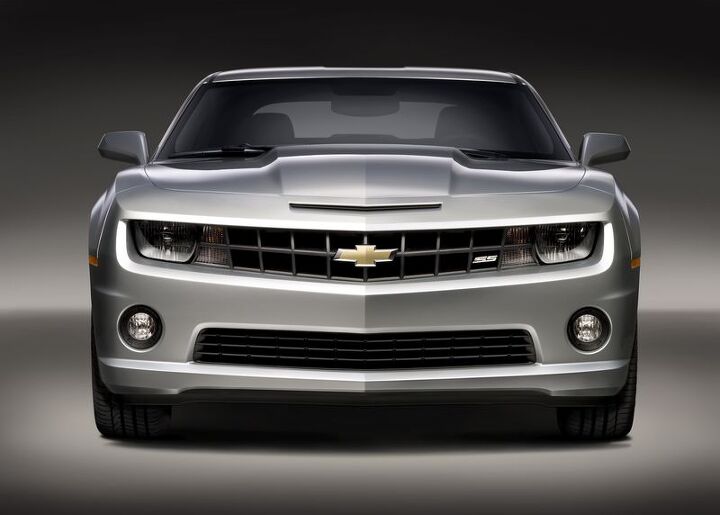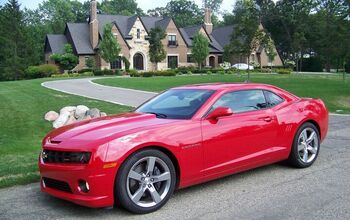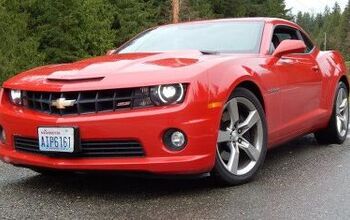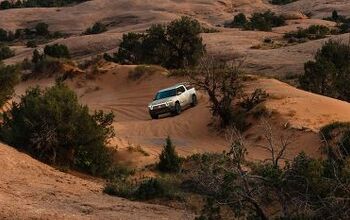Review: 2010 Chevrolet Camaro SS/RS

One of the least publicized aspects of the “New” GM is how much of the old company remains on the books. More to the point, bad ideas with new window dressings still reign (Cutlass) supreme. But not the new 2006—sorry, 2010—Chevrolet Camaro: this idea had the right stuff. On paper. In the real world?
The interior reeks and creaks of GM interior’s stock and trade: look for visual pleasure, yet touch for sensory disapproval. Aside from stitched armrests on the SS’ door panels, Camaro occupants sit between a rock and a hard place. Faux silver trim accents the flimsy vent registers on a brittle dashboard, then encompass the area normally associated with cloth/vinyl padding on the door panels. (Even the Chevrolet Aveo got that right.) Sitting in the Camaro’s cramped rear cubby reinforces the impression. The interior is awash in a blandness that would not feel out of place in a Chrysler Sebring. What happened to the world-class interiors you promised, Mr. Lutz?
That’s not to say the Camaro’s interior can’t be fun. The busy analog gauges sit in retro square binnacles, while secondary readouts rest atop the console, with its pitch-perfect short handle shifter. The SS gets an ergonomic steering wheel complete with an M-series worthy logo on the bottom of the tiller. There’s a respectable Boston Acoustics audio system and the seats aren’t half bad . . . unless you try the thrones in a Dodge Challenger SRT-8.
But Camaro interiors have been crap for years. The spatial challenge never dissuaded the Bowtie faithful for one reason: Chevy’s small block V8. With six smooth-shifting, close-ratio speeds and a burly 6.3 liters and 422hp of LS3 underfoot, the SS’s performance is absolutely right for the nameplate. Aside from the (industry standard) practice of throttle delay at tip-in, the Camaro’s power is effortless, refined and angry enough to ruin an import’s day, one quarter-mile at a time. We’re torquing the mid-to-low 13 second range—much like the outgoing Camaro SS and its low-po LS1 mill.
All of this makes sense, given the fifth-generation Camaro’s portly underpinnings. Blessed with plenty of NVH (noise, vibration, harshness) reducing materials, an independent rear axle and the necessary bulk associated with the Zeta Platform, the 3800lb Camaro SS rides like a champ, obliterating any bump in the road, rolling down the highway like a refined German autobahn cruiser. Pony car heritage be damned, the new Camaro is made for Baby Boomers who remember the good ol’ days, but demand Lexus-like refinement in the prime of their lives.
Aye, there’s the rub. The Chevrolet Camaro still wanders like a lost Taliban in the Tora Bora; angry and full of vigor, but without any focused direction. No longer a Panhard-infused, knuckle-dragging back road barnstormer, the new Camaro has enough inertia-infused body roll to feel like an overstuffed gymnast in quick corners. The multi-branded Camaro/Brembo calipers have a Bumblebee-like identity crisis, but they stop like a Decepticon in Optimus Prime’s wake, sans nose-dive.
The fifth generation Camaro’s marketing push in the “new” GM’s portfolio notwithstanding, it appears the remnants of the old GM are alive and well. Uh-oh. If the latest Camaro was a clean sheet redesign, GM wouldn’t give the Zeta platform the time of day. It’s simply too big and heavy to provide the lively performance associated with the Camaro brand. Sorry, model. Even if GM’s platform engineers got the right bones for the beast, the crap interior proves that the “new” GM isn’t ready for the change that customers, taxpayers and the American economy expect from a company (supposedly) changing its ways.

More by Sajeev Mehta
Latest Car Reviews
Read moreLatest Product Reviews
Read moreRecent Comments
- Brian Uchida Laguna Seca, corkscrew, (drying track off in rental car prior to Superbike test session), at speed - turn 9 big Willow Springs racing a motorcycle,- at greater speed (but riding shotgun) - The Carrousel at Sears Point in a 1981 PA9 Osella 2 litre FIA racer with Eddie Lawson at the wheel! (apologies for not being brief!)
- Mister It wasn't helped any by the horrible fuel economy for what it was... something like 22mpg city, iirc.
- Lorenzo I shop for all-season tires that have good wet and dry pavement grip and use them year-round. Nothing works on black ice, and I stopped driving in snow long ago - I'll wait until the streets and highways are plowed, when all-seasons are good enough. After all, I don't live in Canada or deep in the snow zone.
- FormerFF I’m in Atlanta. The summers go on in April and come off in October. I have a Cayman that stays on summer tires year round and gets driven on winter days when the temperature gets above 45 F and it’s dry, which is usually at least once a week.
- Kwik_Shift_Pro4X I've never driven anything that would justify having summer tires.





































Comments
Join the conversation
I finally sat in a new Camaro a couple of days ago. There was enough headroom for me to sit up straight, but if I leaned forward a few inches my head hit the roof. And I'm not even that tall (6'2".) And the visibility to the back was awful. The windows are really nothing more than opera windows. That being said, the car is beautiful and has great performance and is a good value. It's just a tragedy that the visibility and headroom is so poor. Looks like I'll have to enjoy the new Camaro from a distance.
Being myself, I think any Camaro after 1982, should have been used for running cocaine, and nothing more. After all, that was their fate, wasn't it? Although the Iroc-Z was actually said to be a good engine, I'm not sure if I'd have faith in the whole car. From 1970, to 1979, however, was the prime of it's life. The genes of that decade really show in that front it. Not sure if "bulldog" is an appropriate description. To me, the 1969 Camaro, accept for the famed Yenko/SC, isn't appealing to me. Being that, all GM body styles were the same. Take a look at the Firebird of 1969, it's just a Camaro with a horizontal split in the tailights, and a snap on "V" to the front grill. Needless to say, I wouldn't buy this car. But if I were to buy a Camaro, I think it's obvious which decade I would choose. No pony for me, although I am a huge fan of the Dodge Challenger, but not much else from Chrysler.